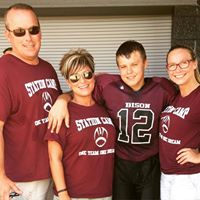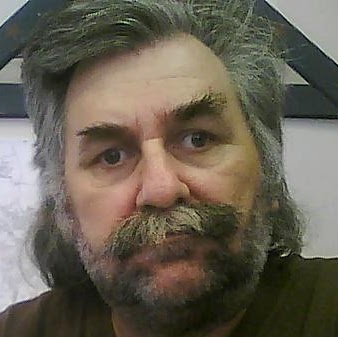Perry C Cook
age ~84
from Portland, OR
- Also known as:
-
- Perry M Cook
- Perry C Mfcc
- Chrisler Cook Perry
- Cook Perry
Perry Cook Phones & Addresses
- Portland, OR
- 113 Hueneme Ave, Oxnard, CA 93035 • (805)9841841
- 208 S Catalina St, Ventura, CA 93001 • (805)9843791
- 682 E Thompson Blvd, Ventura, CA 93001 • (805)6430734 • (805)6432488 • (805)9845993
- 425 Norwood St, Redlands, CA 92373
- 208 S Catalina St, Ventura, CA 93001
Work
-
Address:682 E Thompson Blvd, Ventura, CA 93001
-
Specialities:Psychotherapist
Education
-
Degree:Graduate or professional degree
Languages
English
Specialities
Counseling • Psychology
Isbn (Books And Publications)

Music, Cognition, and Computerized Sound: An Introduction to Psychoacoustics
view sourceAuthor
Perry R. Cook
ISBN #
0262032562
Medicine Doctors

Perry C Cook, Ventura CA - MFT
view sourceSpecialties:
Counseling
Psychology
Psychology
Address:
682 E Thompson Blvd, Ventura, CA 93001
(805)9845993 (Phone)
(805)9845993 (Phone)
Languages:
English

Perry Cook
view sourceSpecialties:
Hematology/Oncology
Work:
New York Methodist Hospital Park Slope Infusion Center
343 4 Ave, Brooklyn, NY 11215
(718)4992169 (phone), (718)4993218 (fax)
New York Methodist Hospital Hematology Oncology
501 6 St APT 3C, Brooklyn, NY 11215
(718)7805541 (phone), (718)7805545 (fax)
343 4 Ave, Brooklyn, NY 11215
(718)4992169 (phone), (718)4993218 (fax)
New York Methodist Hospital Hematology Oncology
501 6 St APT 3C, Brooklyn, NY 11215
(718)7805541 (phone), (718)7805545 (fax)
Education:
Medical School
University of Iowa Carver College of Medicine
Graduated: 1977
University of Iowa Carver College of Medicine
Graduated: 1977
Procedures:
Bone Marrow Biopsy
Bone Marrow or Stem Cell Transplant
Bone Marrow or Stem Cell Transplant
Conditions:
Sickle-Cell Disease
Anemia
Hemolytic Anemia
Hodgkin's Lymphoma
Iron Deficiency Anemia
Anemia
Hemolytic Anemia
Hodgkin's Lymphoma
Iron Deficiency Anemia
Languages:
English
Spanish
Spanish
Description:
Dr. Cook graduated from the University of Iowa Carver College of Medicine in 1977. He works in Brooklyn, NY and 1 other location and specializes in Hematology/Oncology. Dr. Cook is affiliated with New York Methodist Hospital.

Perry F. Cook
view sourceSpecialties:
Diagnostic Radiology, Radiology
Work:
Wind River Radiology PC
1320 Bishop Randall Dr, Lander, WY 82520
(307)3356451 (phone), (307)3324276 (fax)
1320 Bishop Randall Dr, Lander, WY 82520
(307)3356451 (phone), (307)3324276 (fax)
Education:
Medical School
Duke University School of Medicine
Graduated: 1988
Duke University School of Medicine
Graduated: 1988
Languages:
English
Description:
Dr. Cook graduated from the Duke University School of Medicine in 1988. She works in Lander, WY and specializes in Diagnostic Radiology and Radiology. Dr. Cook is affiliated with SageWest Health Care Lander.

Perry C Cook, Ventura CA
view sourceSpecialties:
Psychotherapist
Address:
682 E Thompson Blvd, Ventura, CA 93001
Wikipedia References

Perry R. Cook
Us Patents
-
System And Method For Capture And Rendering Of Performance On Synthetic Musical Instrument
view source -
US Patent:8222507, Jul 17, 2012
-
Filed:Nov 4, 2009
-
Appl. No.:12/612500
-
Inventors:Spencer Salazar - San Francisco CA, US
Ge Wang - Palo Alto CA, US
Perry Cook - Applegate OR, US -
Assignee:Smule, Inc. - Palo Alto CA
-
International Classification:G10H 7/00
-
US Classification:84602
-
Abstract:Techniques have been developed for capturing and rendering musical performances on handheld or other portable devices using signal processing techniques suitable given the somewhat limited capabilities of such devices and in ways that facilitate efficient encoding and communication of such captured performances via wireless networks. The developed techniques facilitate the capture, encoding and use of gesture streams for rendering of a musical performance. In some embodiments, a gesture stream encoding facilitates audible rendering of the musical performance locally on the portable device on which the musical performance is captured, typically in real time. In some embodiments, a gesture stream efficiently codes the musical performance for transmission from the portable device on which the musical performance is captured to (or toward) a remote device on which the musical performance is (or can be) rendered. Indeed, is some embodiments, a gesture stream so captured and encoded may be rendered both locally and on remote devices using substantially identical or equivalent instances of a digital synthesis of the musical instrument executing on the local and remote devices.
-
Continuous Pitch-Corrected Vocal Capture Device Cooperative With Content Server For Backing Track Mix
view source -
US Patent:20110144981, Jun 16, 2011
-
Filed:Sep 4, 2010
-
Appl. No.:12/876131
-
Inventors:Spencer Salazar - Palo Alto CA, US
Rebecca A. Fiebrink - Timmins, CA
Ge Wang - Palo Alto CA, US
Mattias Ljungström - Berlin, DE
Jeffrey C. Smith - Atherton CA, US
Perry R. Cook - Applegate OR, US -
International Classification:G10L 11/04
-
US Classification:704207, 704E11006
-
Abstract:Techniques have been developed to facilitate (1) the capture and pitch correction of vocal performances on handheld or other portable computing devices and (2) the mixing of such pitch-corrected vocal performances with backing tracks for audible rendering on targets that include such portable computing devices and as well as desktops, workstations, gaming stations, even telephony targets. Implementations of the described techniques employ signal processing techniques and allocations of system functionality that are suitable given the generally limited capabilities of such handheld or portable computing devices and that facilitate efficient encoding and communication of the pitch-corrected vocal performances (or precursors or derivatives thereof) via wireless and/or wired bandwidth-limited networks for rendering on portable computing devices or other targets.
-
Continuous Score-Coded Pitch Correction
view source -
US Patent:20110144982, Jun 16, 2011
-
Filed:Sep 4, 2010
-
Appl. No.:12/876132
-
Inventors:Spencer Salazar - Palo Alto CA, US
Rebecca A. Fiebrink - Timmins, CA
Ge Wang - Palo Alto CA, US
Mattias Ljungström - Berlin, DE
Jeffrey C. Smith - Atherton CA, US
Perry R. Cook - Applegate OR, US -
International Classification:G10L 11/04
-
US Classification:704207, 704E11006
-
Abstract:Vocal musical performances may be captured and continuously pitch-corrected at a mobile device for mixing and rendering with backing tracks in ways that create compelling user experiences. In some cases, the vocal performances of individual users are captured in the context of a karaoke-style presentation of lyrics in correspondence with audible renderings of a backing track. Such performances can be pitch-corrected in real-time at the mobile device in accord with pitch correction settings. In some cases, such pitch correction settings code a particular key or scale for the vocal performance or for portions thereof. In some cases, pitch correction settings include a score-coded melody sequence of note targets supplied with, or for association with, the lyrics and/or backing track. In some cases, pitch correction settings are dynamically variable based on gestures captured at a user interface.
-
Social Music System And Method With Continuous, Real-Time Pitch Correction Of Vocal Performance And Dry Vocal Capture For Subsequent Re-Rendering Based On Selectively Applicable Vocal Effect(S) Schedule(S)
view source -
US Patent:20140039883, Feb 6, 2014
-
Filed:Aug 6, 2013
-
Appl. No.:13/960564
-
Inventors:Nicholas M. Kruge - San Francisco CA, US
Gregory C. Thompson - San Francisco CA, US
Perry R. Cook - Jacksonville OR, US -
Assignee:Smule, Inc. - Palo Alto CA
-
International Classification:G10L 21/013
-
US Classification:704207
-
Abstract:Vocal musical performances may be captured and, in some cases or embodiments, pitch-corrected and/or processed in accord with a user selectable vocal effects schedule for mixing and rendering with backing tracks in ways that create compelling user experiences. In some cases, the vocal performances of individual users are captured on mobile devices in the context of a karaoke-style presentation of lyrics in correspondence with audible renderings of a backing track. Such performances can be pitch-corrected in real-time at the mobile device in accord with pitch correction settings. Vocal effects schedules may also be selectively applied to such performances. In these ways, even amateur user/performers with imperfect pitch are encouraged to take a shot at “stardom” and/or take part in a game play, social network or vocal achievement application architecture that facilitates musical collaboration on a global scale and/or, in some cases or embodiments, to initiate revenue generating in-application transactions.
-
Residual Excited Wave Guide
view source -
US Patent:55435785, Aug 6, 1996
-
Filed:Sep 2, 1993
-
Appl. No.:8/115958
-
Inventors:Bryan J. Colvin - San Jose CA
Perry R. Cook - Palo Alto CA
Daniel Gochnauer - Saratoga CA -
Assignee:Mediavision, Inc. - Fremont CA
-
International Classification:G10H 1057
G10H 112 -
US Classification:84622
-
Abstract:Synthesizer models for emulating musical instruments can be improved using an analysis model that compares the output signal of the model to a recording of a desired sound and derives a residual signal that can be used to correct the model. When the original model is a good one, the residual signal is small and takes much less memory to store than is required for a sampled sound.
-
Accurate Pitch Measurement And Tracking System And Method
view source -
US Patent:53533720, Oct 4, 1994
-
Filed:Jan 27, 1992
-
Appl. No.:7/825932
-
Inventors:Perry R. Cook - Palo Alto CA
Julius O. Smith - Palo Alto CA -
Assignee:The Board of Trustees of the Leland Stanford Junior University - Stanford CA
-
International Classification:G10L 902
G10L 914
G10L 908 -
US Classification:395 216
-
Abstract:A quasi-periodic signal is sampled at a specified rate, and then a predicted value of the signal is computed from a set of 2M+1 time lagged signal samples. The time lagged samples are centered in time at an integer multiple P of the signal's sampling period T. sub. s, where P. multidot. T. sub. s is approximately one period of the input signal. The predicted signal value is computed by multiplying each of the 2M+1 time lagged samples by a corresponding predictor coefficient c(i) and then summing the resulting products. The predicted signal value is subtracted from the actual signal value to obtain an error signal. epsilon. During each successive sampling period, the predictor coefficients are updated by adjusting the previously computed predictor coefficients by an amount proportional to the error. epsilon. multiplied by each of the 2M+1 time lagged signal values. Using the updated coefficient values, a phase delay is computed, and then the signal's period is computed as the sum of phase delay and P. multidot. T. sub.
-
Sound Synthesis Model Incorporating Sympathetic Vibrations Of Strings
view source -
US Patent:54689066, Nov 21, 1995
-
Filed:Sep 2, 1993
-
Appl. No.:8/116165
-
Inventors:Bryan J. Colvin - San Jose CA
Perry R. Cook - Palo Alto CA -
Assignee:Media Vision, Inc. - Fremont CA
-
International Classification:G10H 108
G10H 500 -
US Classification:84625
-
Abstract:Synthesizer models for emulating musical instruments are improved to take into account sympathetic string vibrations. One embodiment of the present invention scales an output signal from a sound synthesis model and uses the scaled signal as an input signal for a number of single-string emulations causing the single-string emulations to produce sound signals corresponding to sympathetic string vibrations. The output signals from the synthesis model and from all of the single-string emulations are added together. Another embodiment employs an octave's worth of single-string emulations to emulate the lower strings of an emulated instrument. Still another embodiment is a synthesizer which includes an input bus for accepting a sound signal, scaling means, a plurality of single-string emulations, and means for summing output signals from the string emulations. Embodiments preferably employ waveguide synthesis or the plucked string model to emulate single-strings.
-
Economical Generation Of Exponential And Pseudo-Exponential Decay Functions In Digital Hardware
view source -
US Patent:55572278, Sep 17, 1996
-
Filed:Apr 7, 1994
-
Appl. No.:8/224442
-
Inventors:Perry R. Cook - Palo Alto CA
Bryan J. Colvin - San Jose CA -
Assignee:Aureal Semiconductor - Fremont CA
-
International Classification:G06F 7556
-
US Classification:327346
-
Abstract:Exponential and pseudo-exponential decay function values are generated by scaling a fractional decrease per sampling period by a previous decay function value and then subtracting the scaled fractional decrease from the previous decay function value. In one embodiment, a multiplier multiplies the fractional decrease by the previous decay function value and provides a product signal representing the scaled fractional decrease. An adder subtracts the scaled fractional decrease from the previous decay function value. In another embodiment, a shift block replaces the multiplier and approximates multiplication by a binary shift of the fractional decrease. The size of the shift is determined by the previous magnitude of the decay function as indicated by a priority encoder. Shifting generates a pseudo-exponential decay function which is suitable for music synthesis and can be generated quickly using less expensive hardware.
Resumes

Perry Cook
view source
Perry Cook
view source
Perry Cook
view source
Perry Cook
view source
Perry Cook
view source
Perry Cook
view sourceClassmates

Perry Cook
view sourceSchools:
Schwenksville High School Schwenksville PA 1953-1957
Community:
Mary Fryer, Mae Heffentrager, David Loughery, William Clossin, Kerry Wilson

Perry Cook
view sourceSchools:
Lansing Central High School Lansing NY 1990-1994

Perry Cook
view sourceSchools:
Hopewell Valley Central High School Pennington NJ 1998-2002
Community:
Ericka Feller, Christopher Zsenak, Megan Santosusso, Ashley Hagen, Abigail Stewart, Holl Murphy, Tristen Bryant, Morgan Sayre, Joseph Pellegrino

Perry Cook
view sourceSchools:
Trego Community High School Wakeeney KS 1971-1975
Community:
Kirk Schwien, Cindy Fabricius, Robin Dice, Tina Waldschmidt, Dave Roberts, Ed Stefan, Mark Denchfield, Linda Beaman, Tracy Ries, Linda Lorenz

Dexter High School, Dexte...
view sourceGraduates:
Perry Cook (1973-1977),
Jerry McMenamin (1955-1959),
Joyce Hogan (1970-1981),
Nancy Lawhead (1964-1968)
Jerry McMenamin (1955-1959),
Joyce Hogan (1970-1981),
Nancy Lawhead (1964-1968)
Myspace
Youtube
Flickr

Perry Cook
view source
Perry Cook
view source
Perry Cook
view source
Barbara Perry Cook
view source
Lisa Perry Cook
view source
Perry Cook
view source
Perry Cook
view source
Rhda Perry Cook
view sourceGoogleplus

Perry Cook

Perry Cook

Perry Cook

Perry Cook
Get Report for Perry C Cook from Portland, OR, age ~84


















